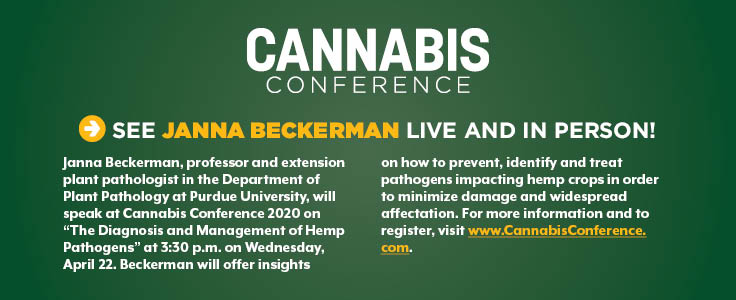Wisconsin Governor Signs Bill to Make Hemp Program Permanent
Marijuana Industry News November 27, 2019 MJ Shareholders

As more farmers take up hemp cultivation, they should be aware of the common and serious diseases that can cause significant crop loss. The 2018 Farm Bill created opportunities for universities to begin studying and researching the pathogens that can impact the hemp plant, and information is beginning to emerge about best practices to manage diseases.
RELATED: Common Marijuana & Hemp Diseases
Here, Janna Beckerman, professor and extension plant pathologist in the Department of Plant Pathology at Purdue University, shares insights into identifying, treating and trying to prevent these pathogens in order to minimize damage and widespread infection.
Hemp Grower: What are some common pathogens that can affect hemp crops?
Janna Beckerman: Every day there are new ones or reports of new ones. Most people see the foliar disease problems long before they actually think of looking at the roots, so I think most common would be problems like powdery mildew. We’ve had several reports of people growing hemp for CBD or for oil, seed or fiber who had problems with rust, and a number of different leaf spot pathogens. We did have people who had planting problems, where the stand didn’t emerge, so these would be the damping off fungi. They didn’t send samples in for diagnoses, but common damping off fungi are pythium, rhizoctonia, fusarium and phytophthora. Especially in the Midwest, it was quite a year because it was so unusually wet.
HG: How can cultivators work to prevent these pathogens?
JB: There are issues where you can grow things in high tunnels, for example. If you are growing hemp for CBD production, that might be an option that you might consider. You can’t prevent rain, but you can keep it out. I’m not saying this is a practice for everybody, but everything comes down to trade-offs, and this would be one potential trade-off that you could do to circumvent rainy conditions in your climate.
Another would be using disease-resistant varieties. Unfortunately, there’s so much by way of new genetics and genetics that aren’t what they say they are that it really is a sketchy period at this point in time as to what’s going on on the breeding side. So, that’s hard to say, but I know we have noticed that certain varieties of hemp are more susceptible to certain diseases than other varieties, and that’s true of all plants and their pathogens. I think as time goes on, we’ll have a better grasp of what is and isn’t susceptible and resistant. I would, at this point, be hesitant to say anything because if someone is telling me it’s variety x, I’m seeing rust on variety x, but it might not actually be variety x, we don’t know what we have. There’s a lack of regulation and standardization is a problem, and intellectual property and patents are also issues.
HG: What are some best practices to identify these pathogens?
JB: Scouting is so important—going out and checking on your crops. Obviously, every day isn’t possible for everyone, but [scouting should be done at least] every few days. One of the issues is even if you identify it quickly, oftentimes there are very few pesticides that are labeled for control and even fewer that are actually effective at controlling pathogens, so you’re kind of stuck.
RELATED: Purdue Researchers Tackle Cannabis Industry’s Pesticide Problem
Some of the things that you can do if you suspect you have a plant disease problem or a plant insect problem is contacting your state diagnostic labs. At least now, most state diagnostics labs can accept samples and diagnose the problem. We certainly can do that here at Purdue. We just ask that you make sure that you’re sending us hemp.
HG: What are some common treatments for pathogens to minimize damage?
JB: Obviously, growing healthy plants is the No. 1 step for reducing the possibility of disease. Many pathogens end up infecting because of too much fertilizer, which is always, I find, a bigger problem than not enough fertilizer. So, make sure you’re fertilizing correctly. This is a challenge because, again, we don’t have all that much information agronomically for what works best. We’re not at a state like where we are for corn and soybeans, for example, so using judicious applications of fertilizer would be your first step.
Make sure your plants are properly spaced. If you’re growing in a greenhouse or any kind of shade house, make sure you practice proper sanitation, so you’re not tracking things in from other places, bringing the problems to you. Pruning sometimes can help. This would be for more high-value CBD crops, where you increase the airflow, which allows the foliage to dry—that’s another approach. Make sure you have good weed control. A number of weeds that commonly infest agronomic crops or horticulture crops serve as reservoirs for other pathogens, whether that’s viral or fungal or even downy mildew. We had huge outbreaks of downy mildew in several areas of the Midwest this year on cannabis.
HG: What do you hope attendees will bring back to their business from your session at Cannabis Conference 2020?
JB: Hopefully, they’ll become educated and not scared. I think this is one of these fields where people are very enthusiastic going in, and they can become quickly discouraged with some of the problems. I think the problems are to be expected, but they can be managed. You need to be patient and take the opportunity to learn, like this opportunity here. I hope they’ll come away feeling more confident in their ability to successfully grow their crop.
MJ Shareholders
MJShareholders.com is the largest dedicated financial network and leading corporate communications firm serving the legal cannabis industry. Our network aims to connect public marijuana companies with these focused cannabis audiences across the US and Canada that are critical for growth: Short and long term cannabis investors Active funding sources Mainstream media Business leaders Cannabis consumers









